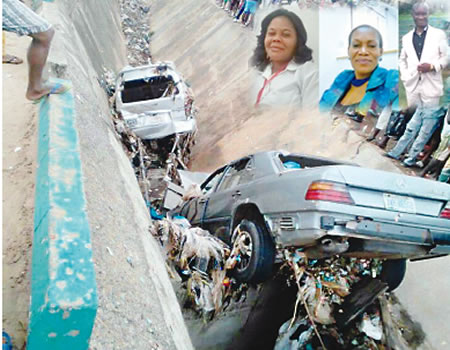According to reports, it had started to rain in the afternoon till early evening when the bankers closed from work. They apparently waited for some time, hoping that the rain would subside soonest, but it did not. They therefore decided to get into an official vehicle driven by the bank’s accountant, not knowing that the flood which had taken over major roads was still capable of causing havoc.
At Kate Junction close to the spot of the incident, a stone’s throw from their office, the four members of staff of United Bank for Africa (UBA), Onitsha branch, met with fate as they were swept into a big drainage.
A source who didn’t want his name in print told Sunday Tribune that no sooner had the bankers got into the vehicle and began to move than the vehicle began to struggle in the flood. According to reports, unable to withstand the strength of the flood, the vehicle later plunged into the Sakamori drainage, a 15-feet deep tributary of River Niger, as all occupants of the car got drowned.
The source told Sunday Tribune that “it was the flood that carried the vehicle into the Sakomori drainage because it is a small vehicle. The driver tried to resist the force of the flood but the vehicle had no weight. That was how it was drowned.
“They were about four, I think with one little girl. I saw as they were panicking inside the vehicle and after the rain, the vehicle was recovered with three out of the four of them excluding the baby girl.
“The next day, the corpse of the accountant who drove the vehicle was picked but the little girl… nobody knows if she has been washed away into River Niger. This Sakomori (drainage) was built to control flood that wreaks havoc whenever it rained in Onitsha and its environs.
“You can see that it is so deep that when the bankers’ vehicle plunged into it, nobody was ready to come to the rescue of the occupants. We were watching them drown; what could we do? The flood on the road was up to two feet high and the Sakamori had overflowed its bank; that was why the roads were flooded that day.”
When Sunday Tribune visited the office of the victims to gauge the mood of their colleagues, the Branch Manager declined to speak because, according to him, he was not permitted to speak on behalf of the bank. He therefore referred Sunday Tribune to the corporate headquarters of the bank in Lagos.
Under the threat of flooding
For quite some time, Onitsha has been on the receiving edge during the rainy season, with multiple flooding often accompanying rainfalls.
In the last few days before the recent tragedy, a similar incident happen in Okpoko, New Heaven Layout, Ogbaru, Anambra State, where two siblings aged 12 and 6 were confirmed dead following massive flooding in the area. Church buildings, fences, vehicles and houses were damaged in the aftermath of the flood.
A 30-year-old groundnut seller in the area, Mrs Agnes Uju, while reacting to the incident, said death resulting from flooding in Onitsha was no longer new. She rather saw the tragedy from the spiritual point of view.
“Since I started selling groundnuts here in the past seven years, flood has been swallowing (sic) people every rainy season. Government is not the cause of this repeated happenings; it is only prayers that can save the situation. So it is devil’s handiwork,” she claimed.
Another resident of the city, Mr. Emmanuel Ibe, in his opinion, alleged that the tragedy was due to impatience on the side of the victims. He, however, urged President Muhammadu Buhari and Governor Obiano to order the state road maintenance agency to constantly clear the drainages to allow free flow of water.
A woman who trades in baby wears, Ngozi Benjamin, said one of the victims was her customer. She suggested to the government to put some structures on the edge of drainages across the state to prevent a recurrence of the tragedy.
A barrow pusher, who did not want to be identified, said that at a point the drainage overflowed its banks, flooding major roads and submerged several vehicles. He added that drainages in the state, including that of Sakomori had always proved incapable of handling heavy flooding.
“The expectation is that the government should expand the existing drainages and make them deeper,” he said, noting that this was necessary so that flood does not submerge the city’s main market.
Solving the problem
The Anambra State Government, sometime last year, announced its intention to commence a study to mitigate the perennial flooding in the Onitsha metro area and its immediate environs.
The government hopes to make this possible through the government’s partnership with the Special Climate Change Fund (SCCF) under the Nigeria Erosion and Watershed Management Project, NEWMAP.
The project, known as Onitsha Stormwater Management Master Plan, was expected to kick off in mid-July and would last for eight months.
The idea is to understand flood and drainage discharge patterns in the wet and dry seasons with intent on developing a lasting solution. Stormwater run-off is the immediate cause of urban flood and gully formation in Anambra State, which negatively impacts on the economy and general well-being of the people.
With this and similar efforts around the state, the Governor Willie Obiano-led government seeks to promote economic security by addressing gully formation, vulnerability to soil erosion and creating a climate-resilient Anambra State, one community at a time.
Onitsha, as the gateway to eastern Nigeria and its economic nerve-centre, is well-chosen for this project given its peculiar location, which combines road and waterway access points, making it one of the four main potential industrial and commercial growth areas in Nigeria.
Hopefully by the time the project is fully on ground, flooding in Onitsha would be a thing of the past.






